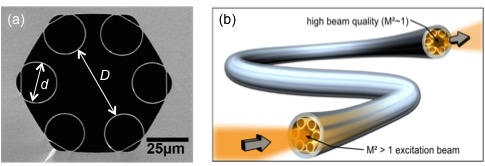Hollow-Core PCF
The main physical principle behind propagation of light in conventional optical fibers is total internal reflection (TIR). However, engineering of optical materials with features on the scale of the wavelength of light offers many new possibilities for manipulating light. In particular, some microstructured fibres make it possible to guide light by a mechanism different from total internal reflection. In these fibres, light is trapped in the core by an out-of-plane band-gap, which appears over a range of axial wavevectors and prevents propagation of light in the microstructured cladding [Cregan (1999)], allowing guided modes to form in the central hollow core [Russell (2003); Russell (2006)].






